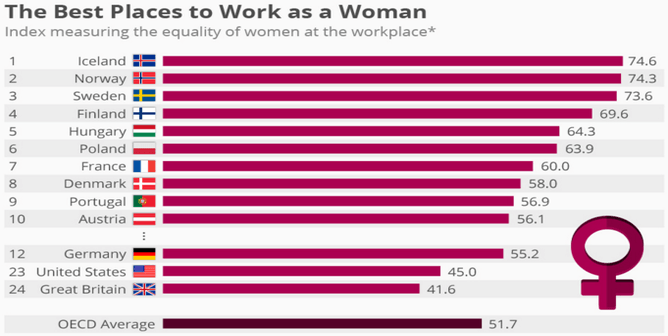Northern Europe Best for Working Women

For The United Nations’ International Women’s Day today, we have a chart which shows where women have the best chances of being treated equally at work. It combines information on education, labour-force participation, salaries, child-care rates, maternity benefits, business-school students and numbers in senior jobs. Paternity rights are also included. Where new fathers take parental leave, mothers return to the labour market, female employment is higher and the earnings difference between men and women is lower. Each country’s score is an average of its performance on ten indexes.
The Nordic countries—Iceland, Norway, Sweden and Finland—top the list. In these countries, women are in the labour force at similar rates to men. Finland has the largest share of women who have higher education compared with men (49% of women have a tertiary degree, and 35% of men). Norway’s gender wage-gap (6.3%) is less than half the OECD average (15.5%).
Women have 44% of seats on company boards in Iceland. Norway and Iceland also have voluntary political-party quotas, as does Sweden where 44% of parliamentary seats are occupied by women, one of the highest rates in the world. Hungary is fifth, having the lowest gender wage gap, of 3.8%. Despite having few women on company boards (11%) and in parliament (10%), Hungary has good paid leave for mothers (71 weeks at 100% of recent pay) and low child-care costs.
At the bottom of the ranking are Japan, Turkey and South Korea, where men are more likely than women to have degrees, to be in the workplace and to have senior positions. Their pay gap is also wide. In Japan and South Korea the good parental-leave system is a response to their older populations and smaller labour force; but in most ways they are far behind the Nordic countries.